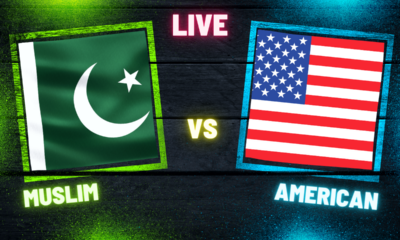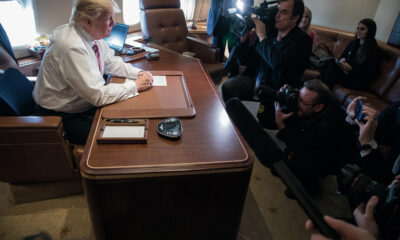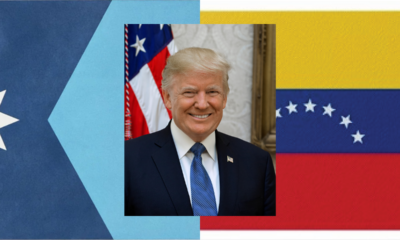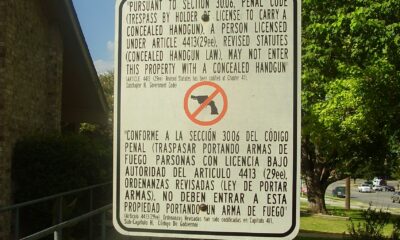Constitution
Second Amendment wins big
Advocates for the Second Amendment scored a landmark victory today as the Supreme Court struck down a 109-year-old New York law.
The Supreme Court today resoundingly affirmed the Second Amendment, and struck terror in the hearts of left-wing bullies. In a key case, the Court struck down the “may-issue” regime of the State of New York. The President, the Governor of New York State, and the Mayor of New York City all condemned the ruling. And if this particular troika condemns something, it must be good.
Supreme Court update
The Supreme Court released four opinions today, including its decision in New York State Rifle and Pistol Association v. Bruen. In the other three, the Court held that:
- North Carolina’s legislative leaders may intervene in a lawsuit challenging the State’s new voter ID law. The North Carolina NAACP is trying to sue away voter ID. The Governor, Attorney General, and Board of Elections are defending that law only half-heartedly. Hence the motions by the North Carolina legislative leaders to intervene. Berger v. North Carolina State Conference of the NAACP.
- A prisoner asking for a substitute method of execution, for which State law does not provide, may still sue under 42 USC section 1983 for unconstitutional maltreatment. Nance v. Ward.
- Failure to “Mirandize” a suspect doesn’t automatically make an interrogator liable. Vega v. Tekoh.
This whittles down the number of cases remaining to decide, to nine, including Dobbs v. Jackson Women’s Health Organization. The Court has one Opinion Issuance Day tomorrow and will likely create one or two Opinion Issuance Days next week.
A new landmark in Second Amendment jurisprudence
Clarence Thomas, the Senior Member of Court, delivered the controlling opinion. At issue is New York State requiring those who apply for a concealed-carry license to demonstrate a “proper cause.” In other words, the applicant must show that he is a direct target or otherwise “needs” to defend himself with a gun more than the average Joe (or Josephine). The New York State Rifle and Pistol Association sued on behalf of two average Joes. Why, they asked, should it matter whether one could show that he was a special target or not? (In fact, such targeting is most effective when the target doesn’t know it.) In short, New York’s law violates the Second Amendment. It also breaks the Fourteenth Amendment, which effectively means no State may violate the federal Bill of Rights.
The District Court denied their claim, and the Second Circuit Court of Appeals affirmed the lower court. The Second Circuit relied on its own precedent of Kachalsky v. City of Westchester, which upheld the “proper cause” standard.
Today the Supreme Court said, NO. The Second Circuit was wrong before and is just as wrong today.
Survey of Second Amendment related law across the States
Justice Thomas identifies six States (and the District of Columbia) that issue licenses to carry firearms only at police discretion. These “may-issue” States are California, Hawaii, Maryland, Massachusetts, New Jersey – and New York. Furthermore, Justice Thomas cited this article in Politifact, listing twenty-five constitutional carry States.
“Shall-issue” means the authorities must issue a permit after someone satisfies some objective, verifiable criteria. “May-issue” means the authorities can pick and choose.
The D.C. may-issue regime has been under permanent injunction since 2017. Various Circuit Courts of Appeals have upheld all the rest.
But perhaps they may do so no longer. Thomas based a solid finding for the Second Amendment on two recent precedents:
- District of Columbia v. Heller (2008), and
- McDonald v. City of Chicago (2010).
Those two precedents established a Second Amendment right to carry a gun for self-defense in the home. Now the Court recognizes a Second Amendment right to carry a gun for self-defense outside the home. This is a right, not a privilege of law enforcement, military, Very Important Persons, or special targets.
The particulars of the cases at hand
Perhaps by way of showing standing, Thomas emphasizes that, if a licensing officer denies a permit, there is little or nothing an applicant can do about it.
Brandon Koch and Robert Nash are two average Joes living, not in New York City, but in Rensselaer County. They also belong to the New York State Rifle and Pistol Association, which explains their interest.
The details of their travails with the licensing officer in Rensselaer County are of little interest. But this brazen declaration by the officer should interest everyone. He asserts that the purpose of restrictions on a carry license is:
to prohibit [Nash] from carrying concealed in ANY LOCATION typically open to and frequented by the general public.Emphasis in original
The two-step dodge of the Second Amendment
Ever since the Supreme Court, in Heller, held that the Second Amendment was an individual right, not a right of the people as a body, various Courts of Appeals have tried to dance around the Second Amendment. Thomas calls this the “two-step framework.” Step One is to review the history of gun laws. Step Two looks at what extra burden a law puts on the Second Amendment – as those Courts understand it.
No more, says Thomas. The Second Amendment, he says, presumptively protects the keeping and bearing of arms. So the history, and only the history, may govern. The biggest problem for the Courts of Appeals is that they have assumed that the Second Amendment right to keep and bear arms applies in the home and only in the home.
Wrong, says Thomas. In his extensive survey of the history, he clearly shows that the Second Amendment codifies a right Americans always had.
Nor does the Second Amendment protect only those weapons in use when James Madison wrote it. Here Thomas seems to have heard the same thing CNAV has heard: “Back then they didn’t have such-a-weapon.” But that does not matter. To quote the Heller case:
The Second Amendment extends, prima facie, to all instruments that constitute bearable arms, even those that were not in existence at the time of the founding.
(Prima facie, or “at first view,” means enough to support a given verdict unless someone can contradict or rebut it.)
A gigantic sensitive place?
Thomas acknowledges that the right to keep and bear arms does not necessary mean the right to carry anything anywhere. Certain “sensitive places” have always existed where one may not carry weapons, including: in school, or in a government building. (But the gun-free school zone might be something new.) Thomas notes that no one has ever disputed whether it is lawful to keep guns out of such places. (He might or might not know about the decision in Utah to let concealed-carry holders carry weapons even into school. Tellingly, untoward incidents have been few, far between, and nothing as tragic as the recent Uvalde Incident.)
But the New York respondents made a problem for themselves. They tried to define a gigantic “sensitive place” to include all public areas where law enforcement is “generally available.”
Respondents’ argument would in effect exempt cities from the Second Amendment.
Touché. Besides, “available” law enforcement almost never responds to prevent crime. Only a magical thinker would suppose that the very availability of law enforcement would be enough of a defense.
Furthermore, Thomas rejects the notion that all but the specially privileged (or targeted) are too dangerous to trust with guns. He finds no support for that in history, and in any event comes down solidly on concepts like:
- “Privileges and immunities of citizens,”
- Due process of law, and
- Incorporation of certain rights that every State must respect.
Devastating historical analysis: Reconstruction
Thomas’ most devastating historical analysis concerns Reconstruction and even the time shortly before the outbreak of the War Between the States. Ironically, the infamous Dred Scott decision recognized a general right to public carry from the Second Amendment! Chief Justice Roger Taney sought to deny blacks citizenship and all the privileges and immunities that go with it. One of these is the right to carry a gun in public in self-defense.
More tellingly, Thomas describes how blacks routinely – and often on advice – carried firearms for their own defense. Indeed he mentions a Freedmen’s School in Maryland, where pupils went to school armed, and the teacher carried a revolver. Bear this in mind in the debate about gun-free schools or school zones.
Did this mean absolutely anyone could carry? No – but someone had to show that he was dangerous to lose his right to carry.
Moving forward, Thomas criticizes the respondents for citing several Western territorial gun laws. The problem for the respondents is that few of these laws came under scrutiny while the territories existed. After those territories became States, those gun laws fell by the wayside. As for the few State gun laws respondents cite, Thomas pithily says they would not withstand scrutiny today.
Second Amendment challenges for the future
This decision does not necessarily allow any and all kinds of weapons. (Justice Kavanaugh points this out in his own opinion.) But it does allow someone to carry the sort of weapon in common use. So perhaps it will remain for another case – or a campaign for repeal of certain laws – to restore recognition of the right of any lawful resident to arm himself at least as well as, if not better than, an infantryman. The 2022 Texas Republican Platform in fact calls for the specific repeal of the foundations of federal gun-control law.
However, Thomas, in a footnote, specifically warns that even the forty-three “shall-issue” States might face Constitutional scrutiny in certain circumstances. “Because any permitting scheme can be put to abusive ends,” Thomas reserves the Court’s authority to intervene if, for example:
- The permitting authority is too slow to process an application, or
- The permitting authority charges a fee only the well-heeled or the well-connected can afford.
Breathless dissent
Justice Stephen G. Breyer gives the dissent. To read it is to wonder whether Justice Breyer even thinks we ought to have a Second Amendment.
As Thomas rather archly observed, Breyer did not even lead with any historical analysis. Instead he starts with a litany of statistics on mass public shootings, suicides, and domestic violence. In other words, Breyer is saying, it’s not safe to let just any average Joe carry a gun in public. Thomas destroys that argument with one quote from the McDonald case:
The right to keep and bear arms . . . is not the only constitutional right that has controversial public safety implications.
Besides, Thomas consistently shows that Constitutional rights do not depend on the implications of the moment. His is not a situational jurisprudence (which is like situational ethics).
Justice Alito comes down even harder on Breyer’s dissent. In sum, he says the New York law didn’t stop the Buffalo shooter, wouldn’t stop a suicide, and wouldn’t be relevant to the domestic-violence cases anyway.
Justice Kavanaugh’s concurring opinion pointed out that this decision leaves the “shall-issue” State laws alone. Here he sets forth the kind of requirements a “shall-issue” State may make:
Those shall-issue regimes may require a license applicant to undergo fingerprinting, a background check, a mental health records check, and training in firearms handling and in laws regarding the use of force, among other possible requirements.
Justice Barrett wrote a two-page concurrence on the proper (and improper) use of history.
Reportage
CNAV has chosen five mainstream media examples for reportage: Reuters, CBS, CNN, NPR, and the Beeb. The CNN link is a “live updates” link that refreshes itself with new information or reaction.
In general, these reports quote the usual suspects. But NPR is good enough to cite an opinion contrary to the breathless alarm by New York Mayor Eric Adams. Specifically, Prof. Glenn Reynolds at the University of Tennessee Law School said:
I heard Eric Adams say that now it’s going to be the wild west in New York, and I’m, like yeah, you’re going to have what? Running gun battles in the streets and on the subway. Oh wait, you already have that.
Hizzoner did use the phrase “wild, wild west,” and talked about “an additional river feeding the sea of gun violence.” Acting Governor Kathy Hochul called it “reckless,” “reprehensible,” and “absolutely shocking.” She even said,
The insanity of the gun culture has now possessed everyone all the way up to even the Supreme Court.
President Biden said the ruling “contradicts both common sense and the Constitution.” Remember that he shows little respect for the Constitution himself. As to “common sense,” to him that means that only the officially trusted should even touch a gun.
What next? The Second Amendment has better protection
Justice Kavanaugh, in his concurrence, suggested that the six “may-issue” States (and the District of Coumbia) become “shall-issue” States instead. They might have to. This Court now seems determined to interpret the Constitution according to its original meaning. The days of the Supreme Court regarding the Constitution as “a living document” are over.
But what exactly happens next? Will New York City and State double down on enforcement of their law? How will other States react? What will it take to impress on people that Courts may no longer change the meanings of words? And what will happen to the Senate Gun Deal, that is likely to pass the Senate? Will we next see a direct challenge to that law the instant the President signs it? Stay tuned.
Terry A. Hurlbut has been a student of politics, philosophy, and science for more than 35 years. He is a graduate of Yale College and has served as a physician-level laboratory administrator in a 250-bed community hospital. He also is a serious student of the Bible, is conversant in its two primary original languages, and has followed the creation-science movement closely since 1993.
-

 Civilization4 days ago
Civilization4 days agoMuslima (Political Candidate) In Ohio: “I Might Have A Bomb-Gun,” On A School Bus Filled With Children – In America! (Video Resurfaces)
-

 Civilization2 days ago
Civilization2 days agoTrump’s Venezuela Gamble and America’s Shifting National Security Strategy
-

 Civilization2 days ago
Civilization2 days agoOperation Absolute Resolve: Anatomy of a Modern Decapitation Strike
-

 Civilization2 days ago
Civilization2 days agoTen Reasons To Cheer the Arrest of Maduro
-

 Civilization3 days ago
Civilization3 days agoTrump delivers deeds, not words
-

 Civilization4 days ago
Civilization4 days agoVP Vance’s Splinter Problem
-

 Civilization2 days ago
Civilization2 days agoTrump’s New Executive Order on Space Has the Right Stuff
-

 Executive2 days ago
Executive2 days agoWaste of the Day: Federal Loans Potentially Had Conflicts of Interest













This ruling like the Heller ruling still is not enforcing Amendment 2 as written. It is a step in the right or correct direction. The Federal Government nor any State Government can regulate who can own, keep, or carry Arms. Amendment 2 is explicit. The only exception is if a person is subject to Amendment 13 in which the person is basically property of the Government(s) and only has PRIVILEGES granted by those in control. But if a person is released from prison and is not on parole or probation they can own, keep, and carry Arms. Amendment 2 could have been written as these two sentences:
A well regulated Militia, being necessary to the security of a free State, shall not be infringed.
The right of the people to keep and bear Arms shall not be infringed.
instead of:
A well regulated Militia, being necessary to the security of a free State, the right of the people to keep and bear Arms, shall not be infringed.
[…] and Sonia Sotomayor collaborated on a dissent. That dissent, like Breyer’s dissent in the famous Gun Law Case, focuses on effects, not law. To read either dissent is to wonder whether Breyer and his colleagues […]
[…] not been shy about revoking certain exercises of executive powers as invalid. We saw that in the New York Gun Case. Perhaps we’ll see it again. If so, then the next time someone wants to denounce something as a […]
[…] v. Miller doesn’t quite fall to New York State Rifle and Pistol Association v. Bruen, but it does come under threat. Federal firearms regulation was not at issue. But State […]
[…] last is a direct nod to the New York State may-issue law that the Supreme Court recently struck down. (New York State Rifle and Pistol Association v. […]
[…] central, landmark Second Amendment case this term is New York State Rifle and Pistol Association v. Bruen. At issue in that case was New York […]
[…] central, landmark Second Amendment case this term is New York State Rifle and Pistol Association v. Bruen. At issue in that case was New York […]
[…] also Justice Steven G. Breyer’s dissent in New York State Rifle and Pistol Association v. Bruen. He […]
[…] New York State Rifle and Pistol Association v. Bruen […]
[…] transportation boondoggles, and gun control (cue Justice Clarence Thomas clearing his throat), and the Green New Deal. Before wrapping up with more self-congratulation, he left this Parthian […]
[…] themselves for self-defense. But this is Illinois. Gun control in Illinois isn’t quite like the May-Issue states (California, Hawaii, Maryland, Massachusetts, New Jersey, and New York). But it comes close, and […]